PROTECT YOUR DNA WITH QUANTUM TECHNOLOGY
Orgo-Life the new way to the future Advertising by Adpathway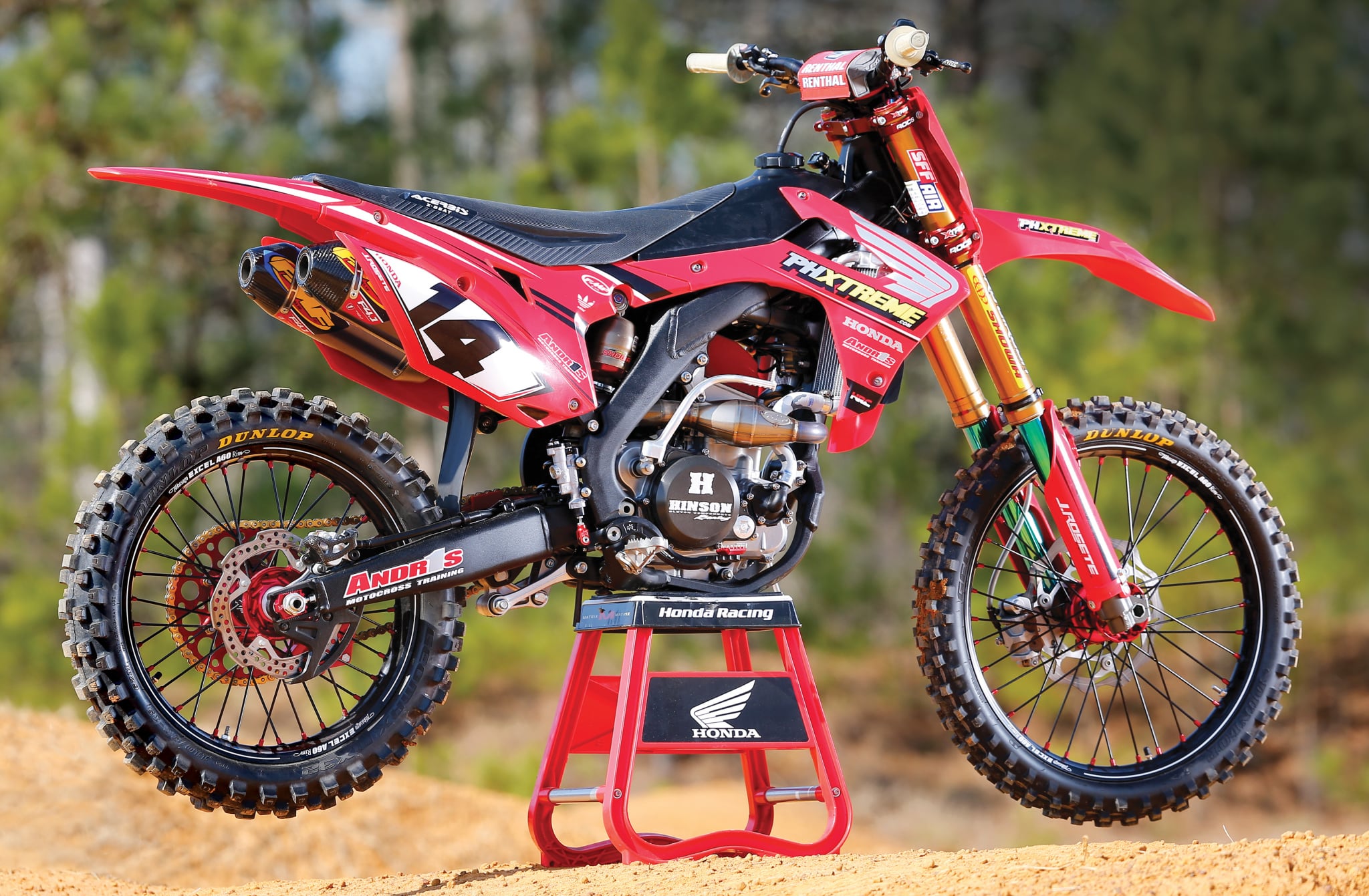 How can a project bike cost $53,000? It’s easy if you start by buying Cole Seely’s TLD Honda CRF250 for $18,500 and spend even more money to buy Malcolm Stewart’s Geico Honda CRF250, and then use them to build one project bike.
How can a project bike cost $53,000? It’s easy if you start by buying Cole Seely’s TLD Honda CRF250 for $18,500 and spend even more money to buy Malcolm Stewart’s Geico Honda CRF250, and then use them to build one project bike.
Not all project bikes are built the same. There’s great disparity between the haves and have-nots in the high-dollar game of creating the ultimate motorcycle. Money is usually the driving force, but a project build can go far astray without the proper vision. MXA test riders are guilty of blowing through their savings accounts buying aftermarket parts, only to realize their mechanical compass was off. The mighty dollar may rule the world, but it does not control who wins on the racetrack.
Because MXA focuses on testing bikes and products, we are often petitioned by industry magnates, race teams, aftermarket companies and friends to test their project bikes. While we’re flattered by the opportunity to destroy someone else’s bike, we turn down most of these requests. Enough project bikes have rolled through our pit area for us to realize that simply bolting on parts and slapping stickers on new plastic doesn’t move the needle.
YOU’RE PROBABLY WONDERING HOW A MOTORCYCLE SUPERSTORE IN MIAMI COULD POSSESS FACTORY EQUIPMENT, DESPITE THE FACT THAT HOLGADO DOESN’T FIELD A PROFESSIONAL RACE TEAM.
We’re constantly searching for the unobtainable and the overwhelmingly unique. That is where Pablo Holgado, owner of the PHXtreme motorcycle superstore in Miami, Florida, comes in. The Argentinian contacted MXA about testing his prized Honda CRF250, replete with factory Honda footpegs, the latest Showa A-Kit air forks and enough titanium to build an SR-71 Blackbird. After we got the call, we were on the next flight to Tallahassee, Florida, where we ventured out to Climax Motorsports Park in Climax, Georgia, to test Holgado’s CRF250.
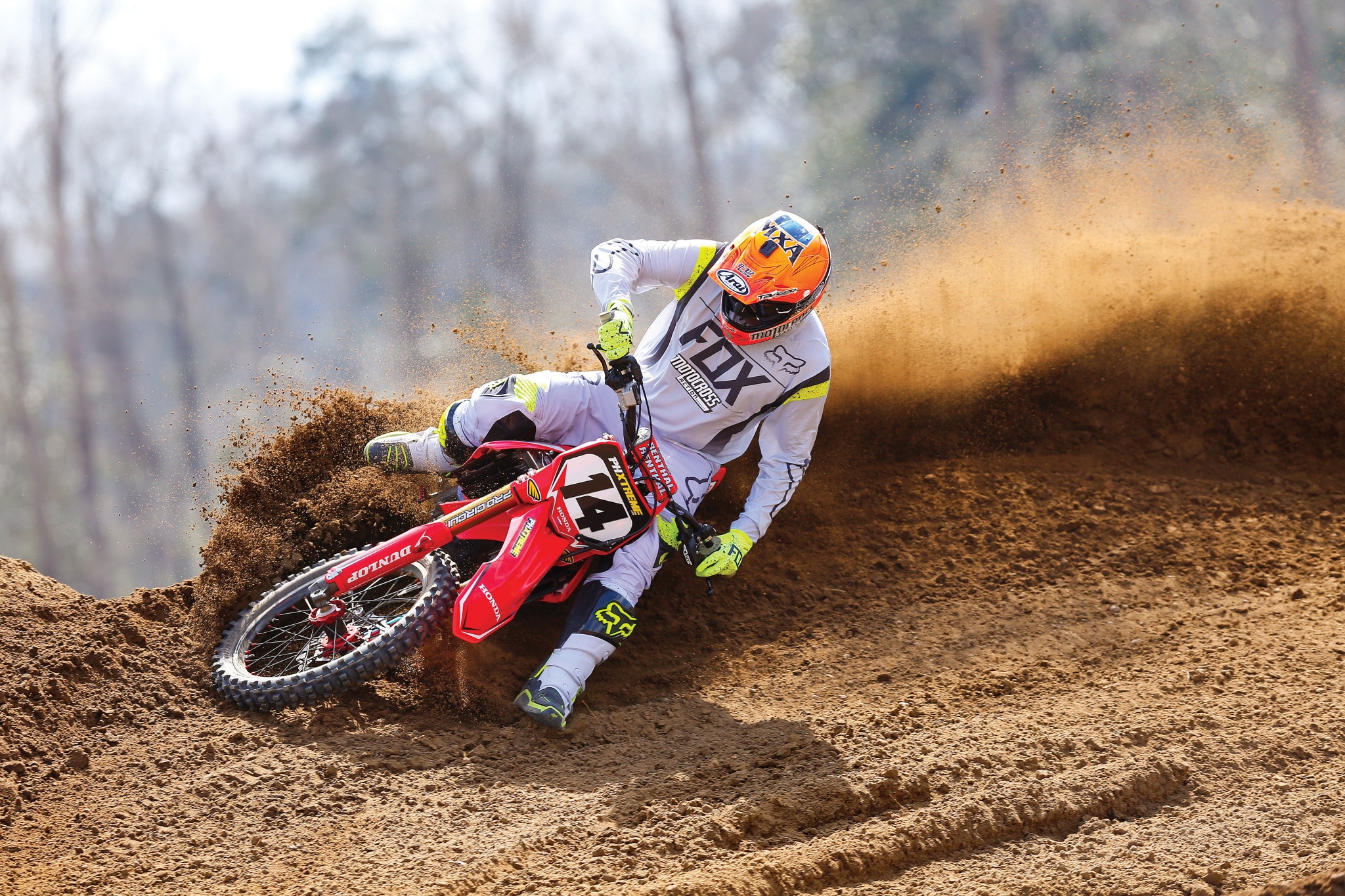 On the track, the works-bike bones of the PHXtreme Honda CRF250 could never be used to their fullest because it was set up for an amateur rider.
On the track, the works-bike bones of the PHXtreme Honda CRF250 could never be used to their fullest because it was set up for an amateur rider.
You’re probably wondering how a motorcycle superstore in Miami could possess factory equipment, despite the fact that it doesn’t field a professional race team. Ever the businessman, Holgado moves more Troy Lee Designs gear through his store than Donald Trump quotes make headlines. As a result, Holgado was noticed by Troy Lee, and the two struck up a conversation about the TLD race team. Troy was in the process of switching from Honda to KTM factory support and was cleaning out his CRF250 inventory. One thing led to another, and Pablo Holgado purchased Cole Seely’s 2014 Honda CRF250 from Troy Lee for $18,500. The bike included factory Honda footpegs (rumored to cost $5000) and a bunch of other trick components.
ON PAPER, THE PHXTREME HONDA CRF250 SEEMED LIKE A DREAM RIDE; HOWEVER, WAS THAT ACTUALLY THE CASE? YES AND NO.
Fast-forward a year later, and Holgado purchased Malcolm Stewart’s Geico Honda CRF250 from James Stewart Sr., also known as “Big James.” This wasn’t actually the first Stewart bike Pablo had acquired from the Stewart camp. His crown jewel is James Stewart’s factory Kawasaki SR125, which hangs from the ceiling directly above the showroom entrance to the PHXtreme superstore. Holgado and the Stewart family formed a friendship through multiple business transactions, and Pablo frequents Bubba’s Haines City, Florida, slice of motocross nirvana.
This is where things get really interesting. Pablo, seizing the opportunity to combine multiple high-end race parts into one ultimate machine, poured a ridiculous amount of money into a stock 2016 Honda CRF250. The end result is what you see here—a CRF250 that is on par with what factory-backed race teams roll through the paddock. Pablo’s creation includes factory Honda footpegs, a Showa A-Kit shock and air forks (off Malcolm Stewart’s race bike), thousands of dollars in titanium, and enough aftermarket parts to push the total cost of the bike up to $53,000.
Here’s what you need to know about the PHXtreme 2016 Honda CRF250.
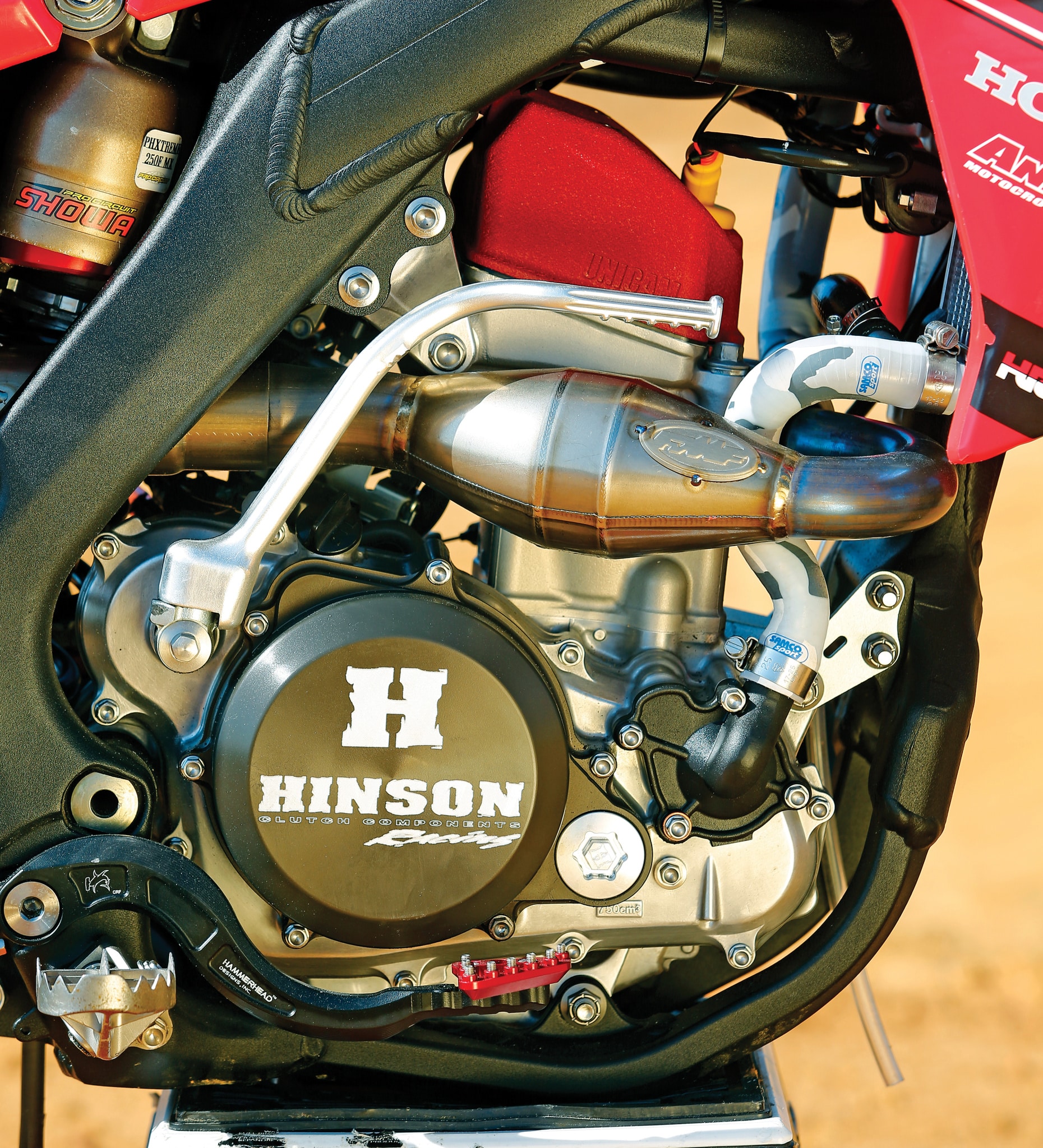 The transmission and shift mechanisms were R.E.M.-finished. The crankshaft was balanced, and Del West titanium valves were installed.
The transmission and shift mechanisms were R.E.M.-finished. The crankshaft was balanced, and Del West titanium valves were installed.
Engine. Jason Rosete, a former wrench for Ian Trettle, Nick Paluzzi and Hunter Hewitt, has a wealth of experience working on race bikes. A native Floridian, Rosete did all of the dirty work on the CRF250. Everything that could possibly be done to the internals was achieved with copious amounts of greenbacks via Holgado’s wallet. The transmission and shift mechanisms were R.E.M.-finished. The crankshaft was balanced and trued. Both cases were polished and deburred. Del West titanium valves were installed. A Pro Circuit camshaft with proprietary springs and titanium retainers replaced the stock components, and the intake tract was blueprinted. Naturally, the cylinder head was ported for better performance, and a custom JE piston is responsible for pumping fuel through the engine.
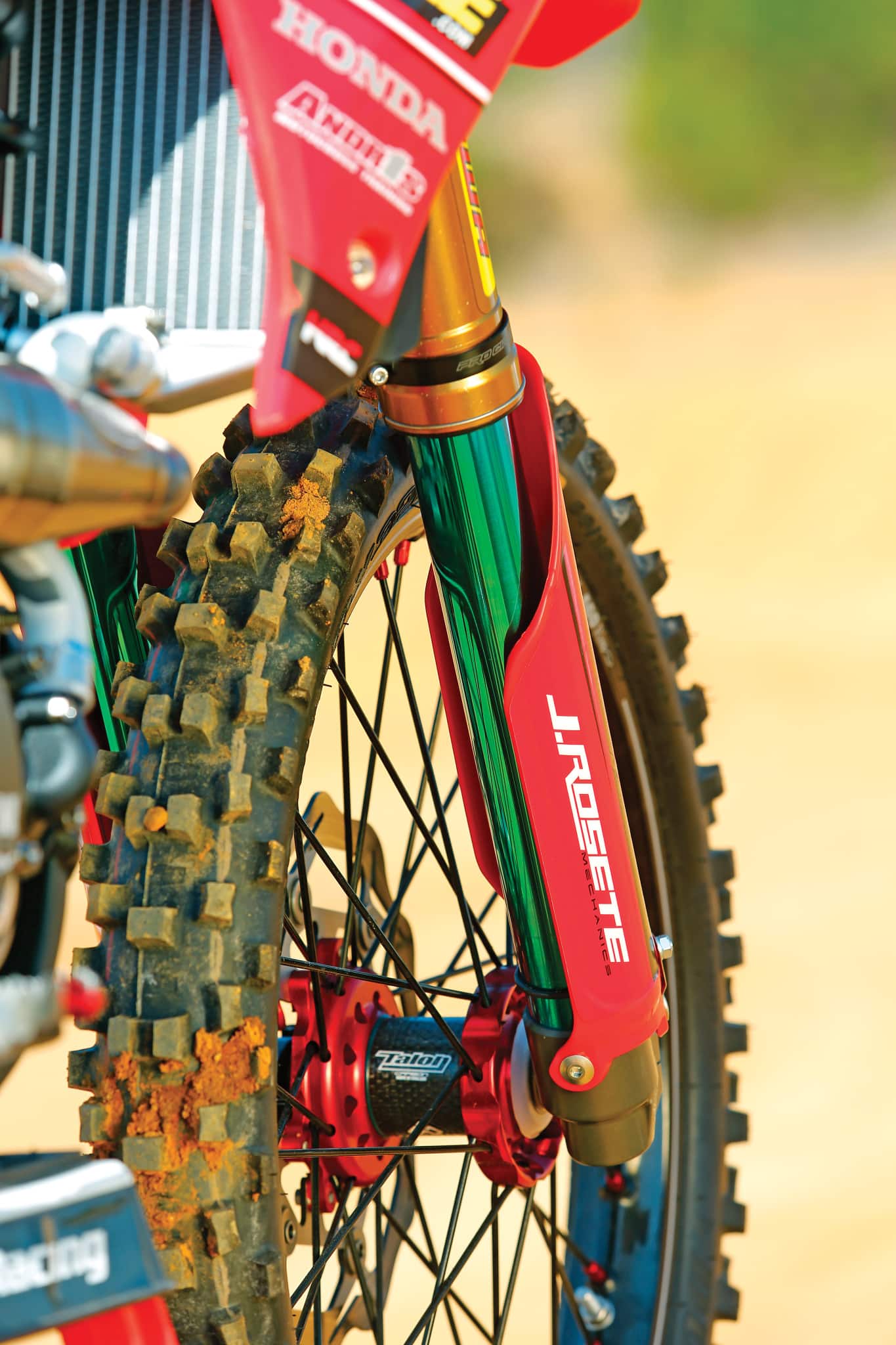 The Showa A-Kit forks were from Malcolm Stewart’s Geico Honda. The cost is $9000, not counting the Xtrig ROCS triple clamps.
The Showa A-Kit forks were from Malcolm Stewart’s Geico Honda. The cost is $9000, not counting the Xtrig ROCS triple clamps.
Those modifications would be enough for most thrill seekers, but not Pablo Holgado. He enlisted Wade Wilcox from Injectioneering to modify the fuel injector. Tokyo Mods customized a Vortex ignition for the perfect balance of power and performance. Pablo even had Jason Rosete get the frame, subframe and swingarm powder coated black—at a cost of $900. Not only would the bike romp around the track, but it would be a show pony in the pits.
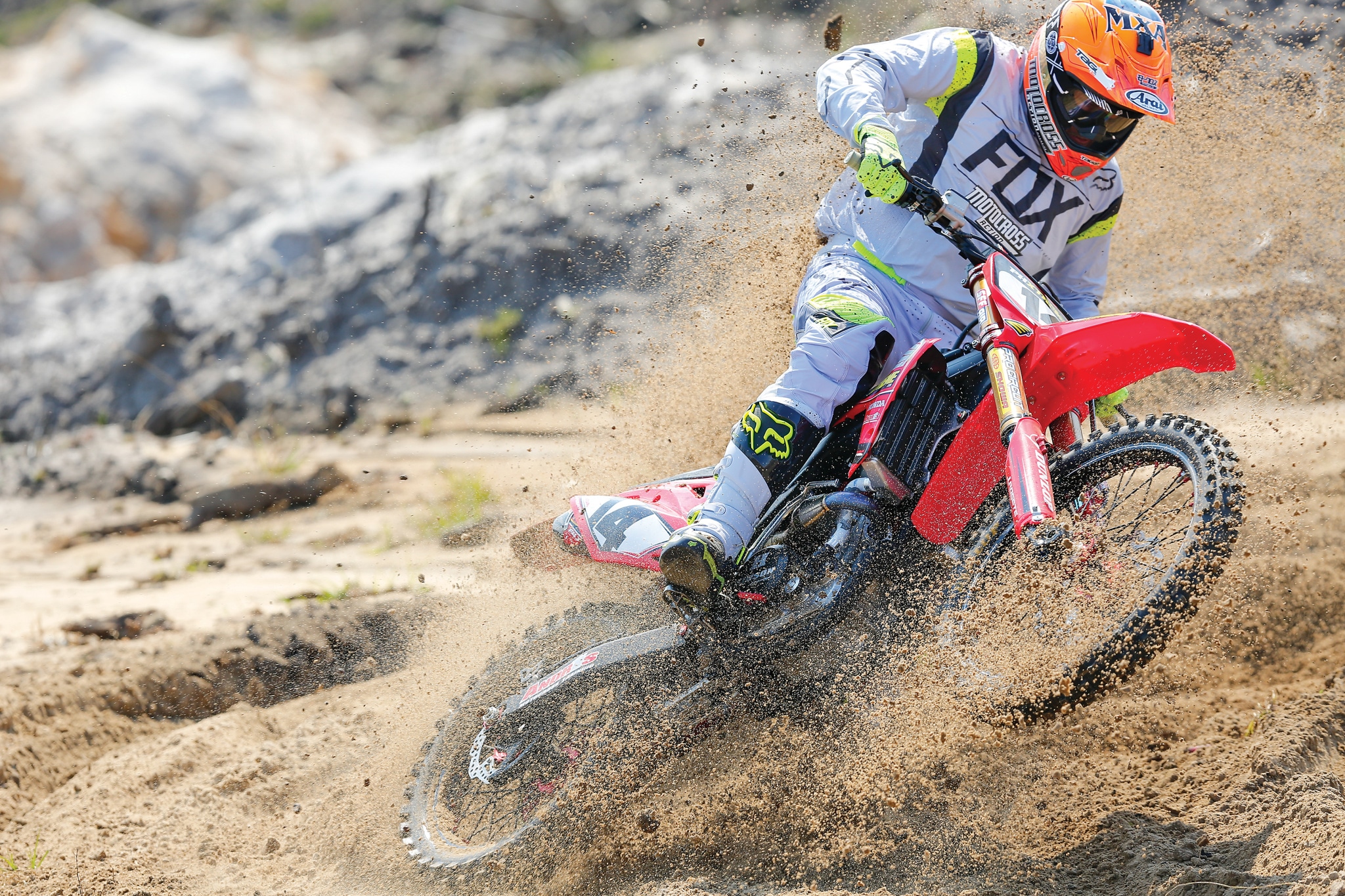 True joy came when we twisted the throttle to unleash a massive surge of midrange power.
True joy came when we twisted the throttle to unleash a massive surge of midrange power.
Aftermarket mods. If you’re interested in spending thousands of dollars in hop-up parts, all you need to do is embrace Holgado’s spending habits. He drop-kicked the stock wheels for Excel A60 rims and Talon carbon fiber hubs from Dubya. In place of the heavy CRF250 dual exhaust is an FMF titanium Factory 4.1 dual system with carbon fiber end caps. The stock red and white plastic was too dull, so he brightened things up with a complete Cycra Racing plastics kit. To complement the $9000 Showa A-Kit forks, he used XTrig ROCS triple clamps. Additional features include a Pro Circuit holeshot device, Samco water hoses, and a Lightspeed carbon ignition cover, rear caliper and case guard. Twin Air handles the air filtration, while a Braking front rotor and standard rear disc bring the bike to a stop. The bike uses Renthal sprockets, handlebars and grips. And while the Renthal handlebars and grips increase comfort, the same cannot be said about the Acerbis X-Seat.
Other products include a Pro Taper chain and throttle tube, TM Designworks Slide-N-Glide kit, ARC folding levers, and a Hammerhead brake pedal, shifter, case saver, axle blocks, brake clevis and oil-filter cover. A healthy dose of cash was put towards a complete Mettec titanium bolt kit. At one point, Holgado dropped an 8mm titanium bolt while removing the seat. He quickly picked it up and said, “That right there is seven dollars.” The bike was buttoned up with a custom PHXtreme graphics kit.
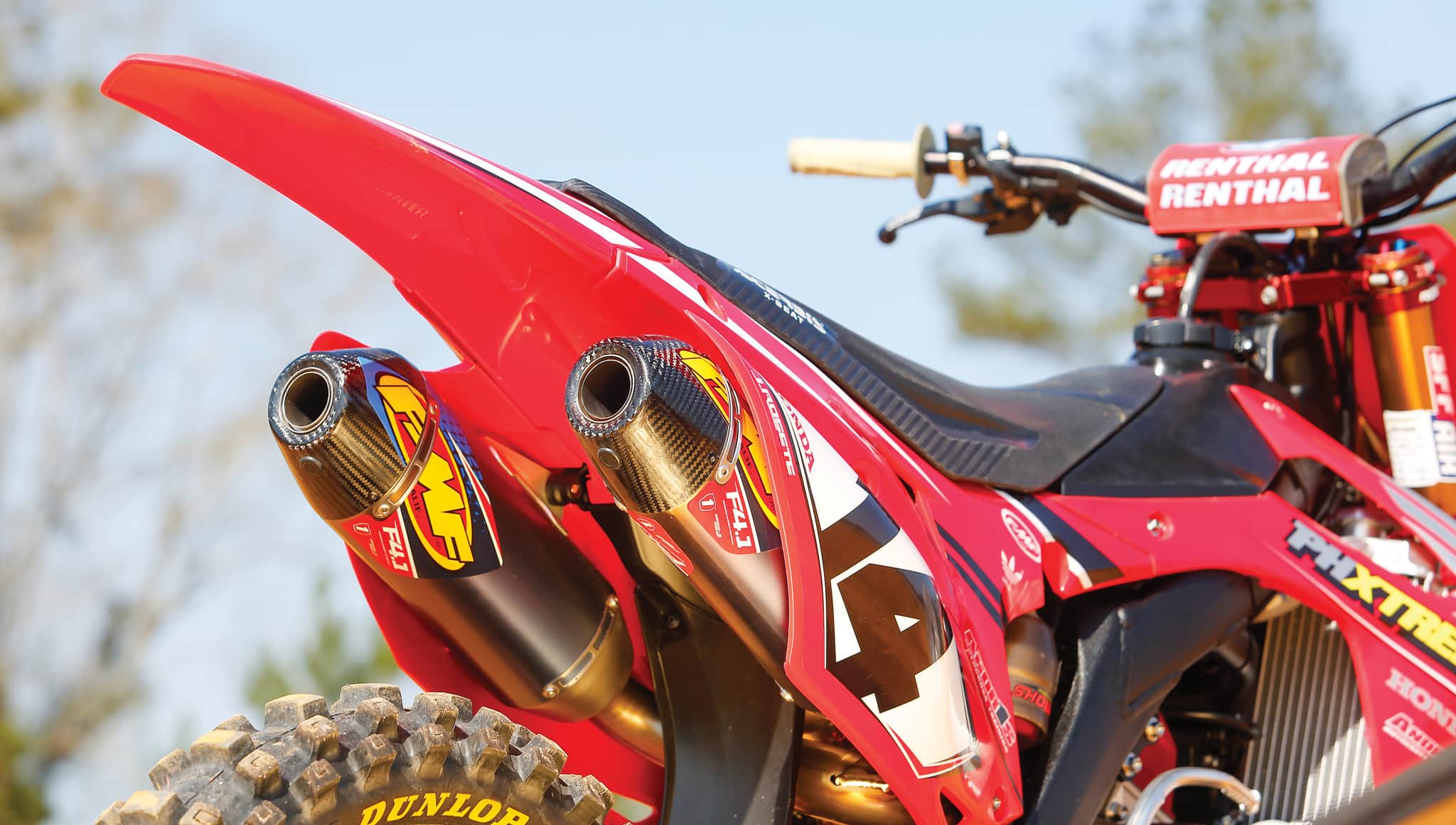 Not just one titanium FMF Factory 4.1 but twice pipes.
Not just one titanium FMF Factory 4.1 but twice pipes.
On paper, the PHXtreme Honda CRF250 seemed like a dream ride; however, was that actually the case? Yes and no. The inherent problem with testing someone else’s bike is that it’s not set up for MXA’s motley crew of test riders. We take that into account during every test session and often give the bike the benefit of the doubt. With that said, the suspension was too soft for our tastes. The general consensus among motocross riders is that money and performance go hand in hand. Unfortunately, larger fork stanchions and space-age coatings cannot cover up marshmallow valving. The Showa A-Kit air forks performed well, with the caveat that they were valved for a 150-pound C-class rider. There’s nothing wrong with that—we just didn’t match the profile. The suspension rode down in the stroke, which caused the rear end to gallop in consecutive braking bumps. The front end over-steered because the forks sat too low. Stiffening the compression produced harshness. We should reiterate that Pablo’s suspension wasn’t set up for us. Maybe we should spend less time eating T-bones and more time at the salad bar.
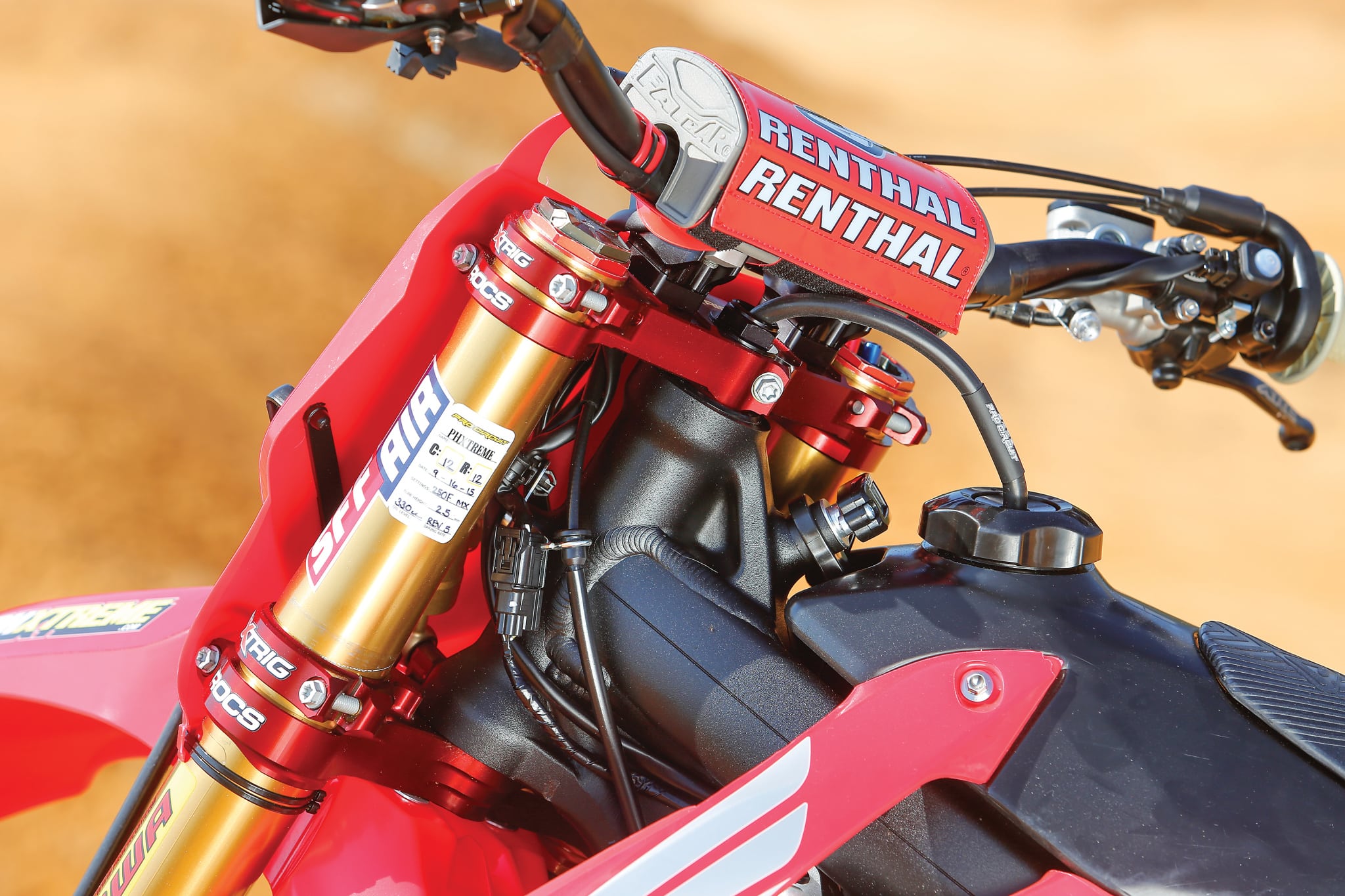 The powder coated frame makes the Xtrig triple clamps and Showa works forks stand out.
The powder coated frame makes the Xtrig triple clamps and Showa works forks stand out.
However, true joy came from twisting the throttle, which resulted in a massive surge of power through the midrange. The CRF250’s powerband characteristics weren’t altogether different from those of a stocker—decent bottom end and strong in the mid. Overall, the horsepower was bolstered everywhere along the curve. As with any race motor, we needed to carry corner speed in order to stay on the pipe. We were pleased that the engine was manageable at high rpm instead of giving up the ghost or bouncing off the rev limiter like a toddler binging on candy. Our best results came by clicking gears when the powerband began to venture into the top end. Doing so maximized the impressive surge of the Rosete-built CRF250 throughout the midrange.
WHO KNOWS? MAYBE WE CAN CONVINCE PABLO TO LOWER JAMES STEWART’S
FACTORY KAWASAKI SR125 FROM THE CEILING AND PUT SOME PRE-MIX IN THE TANK.
As with any project bike, there were things we liked and things we didn’t care for. The Braking oversized front rotor wasn’t any bigger than the stock disc, but it provided better modulation. We were also fond of the Renthal handlebars and Kevlar grips. Conversely, we couldn’t come to terms with the hard Acerbis X-Seat. A few laps in and it felt like we were sitting on a two-by-four. The Hammerhead rubber shifter was also difficult for some of our test riders. For some reason the riders weren’t able to catch the rubber knob with their left foot when shifting up, leading to an inordinate number of missed shifts. Of course, those problems didn’t seem like such a big deal the second we looked down at the works HRC Honda footpegs. Chocolate might be a girl’s best friend, but titanium footpegs are a motocross racer’s true love.
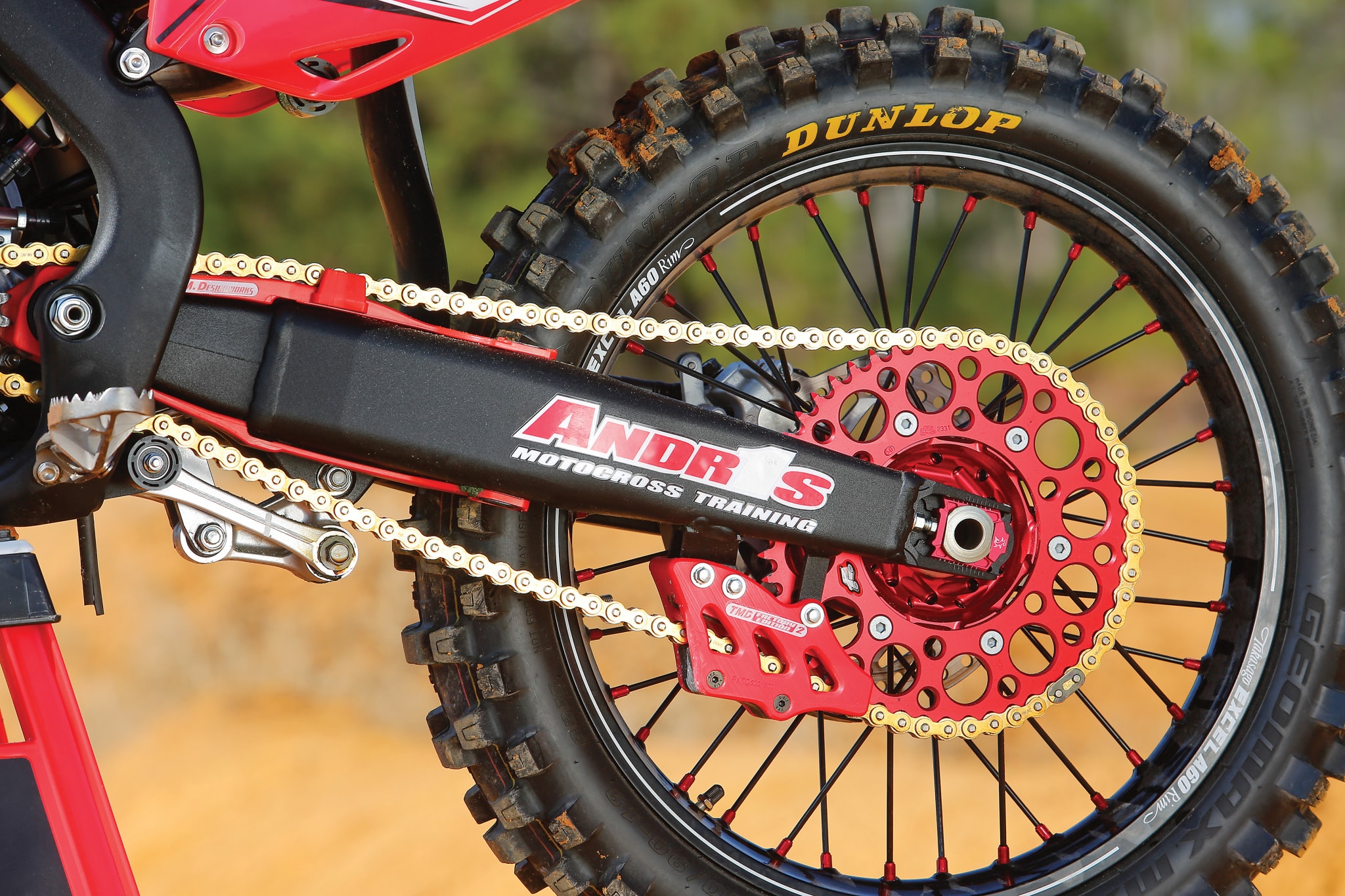 Since the frame had been powdercoated, the swingarm got the same treatment.
Since the frame had been powdercoated, the swingarm got the same treatment.
It’s not unusual for the MXA wrecking crew to test a bike with so many hop-ups, but to do so at a pristine track in southern Georgia is rare. Pablo Holgado’s 2016 Honda CRF250 very well might be the most expensive 250 four-stroke we have ever tested—short of a factory bike—and for that experience, we are thankful. The next time we visit Florida, we will be sure to check out the PHXtreme motorcycle superstore in Miami. Who knows? Maybe we can convince Pablo to lower James Stewart’s factory Kawasaki SR125 from the ceiling and put some pre-mix in the tank.
For more information on PHXtreme, visit www.phxtreme.com or call (305) 594-2284. You can also swing by their superstore in Miami, which is open six days a week.




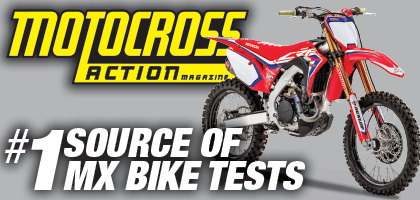



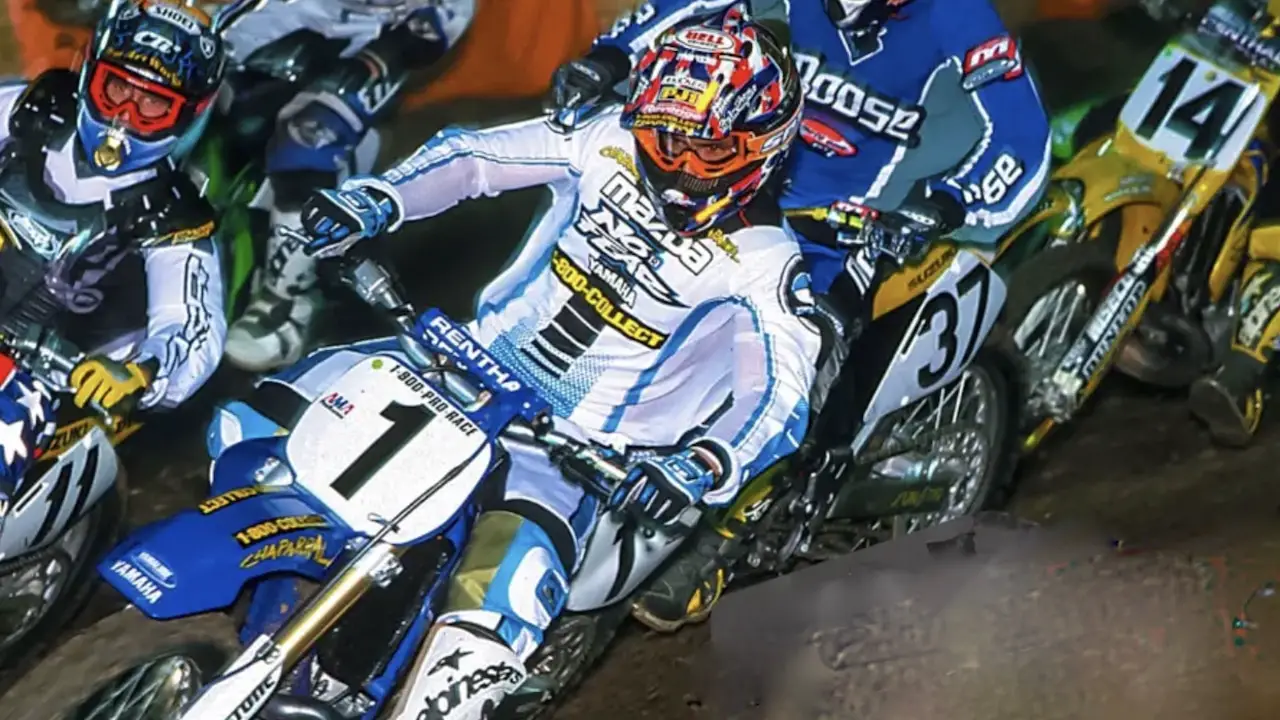






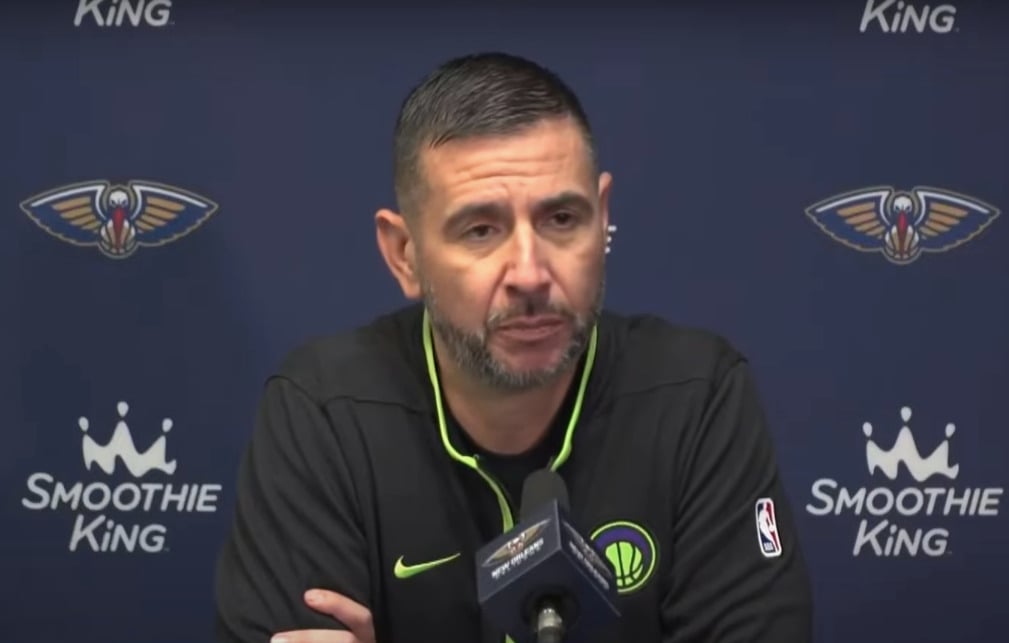
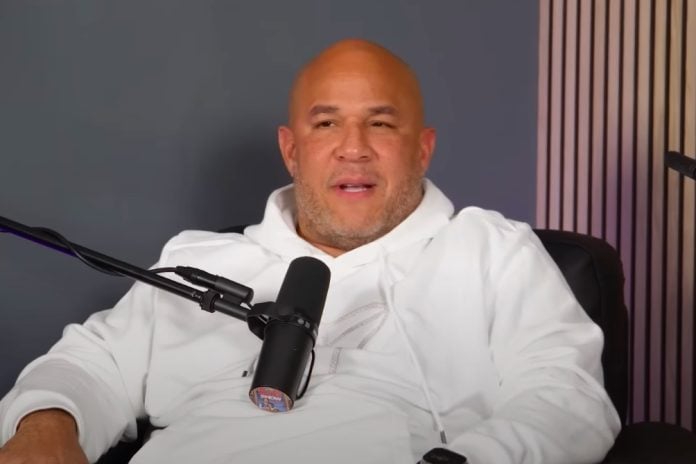


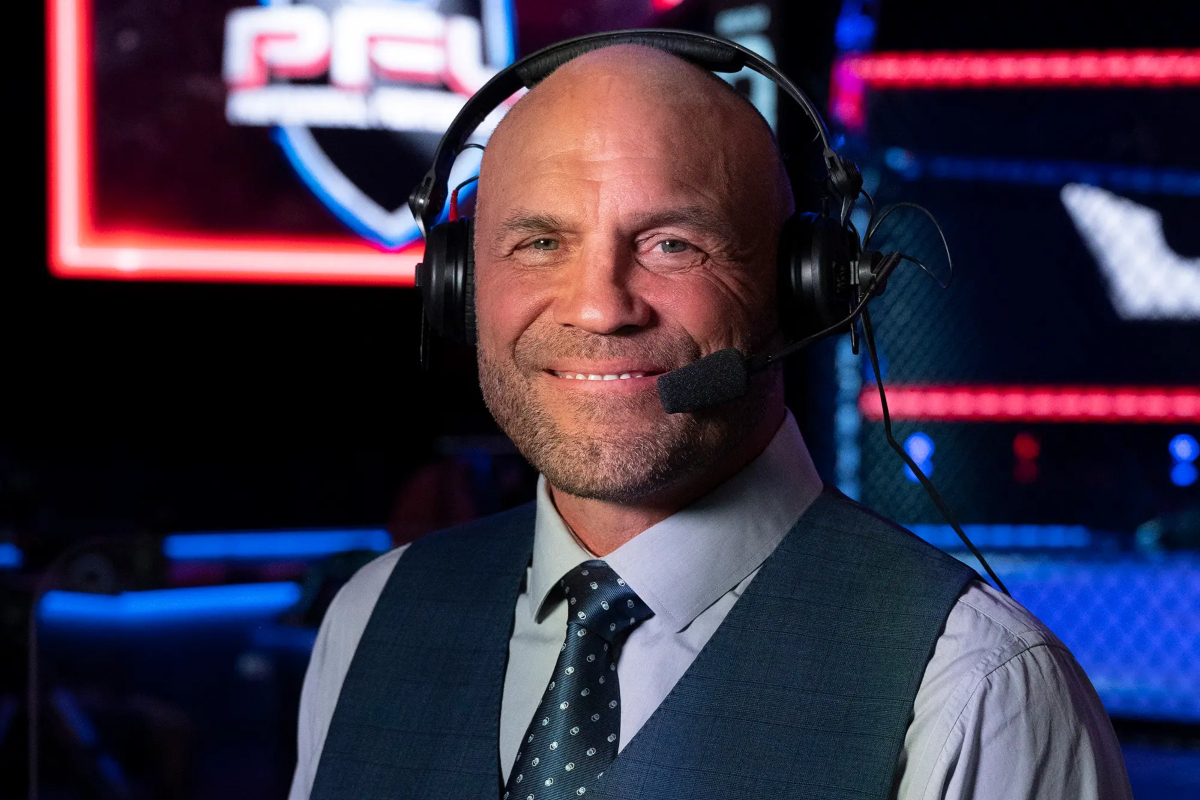
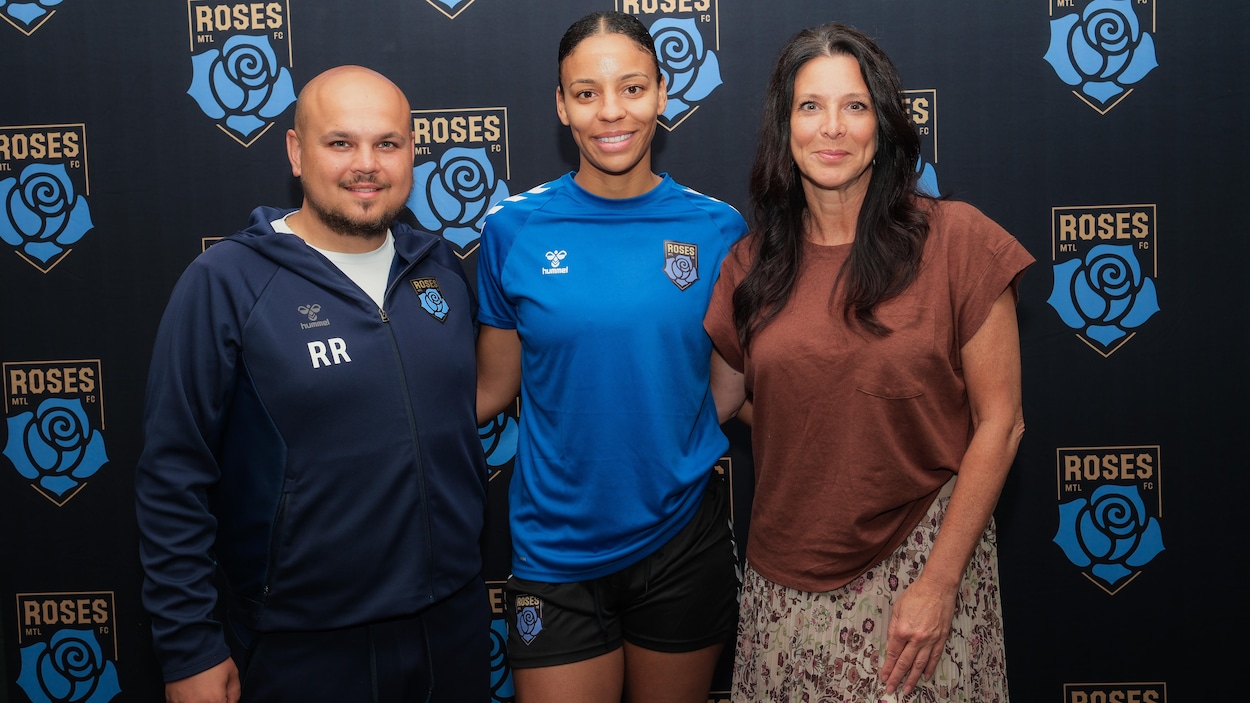

 English (US) ·
English (US) ·  French (CA) ·
French (CA) ·